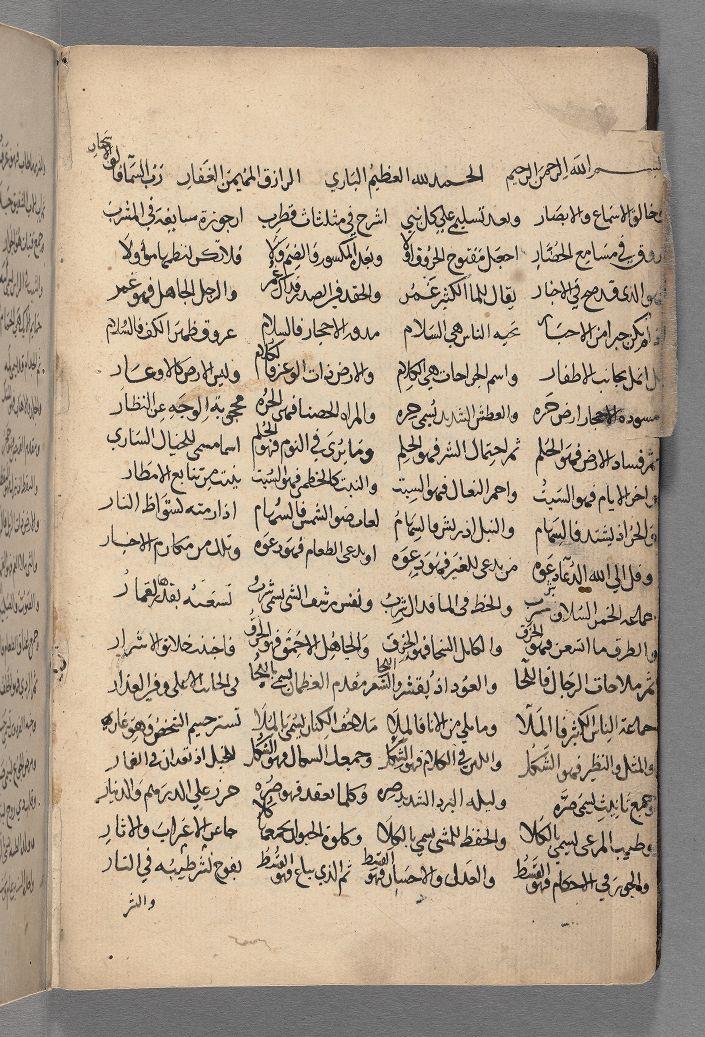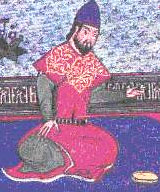|
Abu Esmail Moayed-o-din Togharayi
Abu Esmail Moayed-o-din Hosein-ebn-e-ali Esfahani Togharayi was an Iranian poet and scholar of the Seljuq period. He was born in Isfahan, Iran in 1045 A.D. He had mastered all sciences of his time, and he also wrote some books about alchemy, such as ''Jame-ol-asrar'', ''Trakib-ol-anvar'', and ''Masabih-ol-hekmat va Mafatih-ol-rahmat'', ''Haghaegh-ol-esteshhadat'', ''Zat-ol-faraed'', and ''Alrad Ali-ebn-e-sina fi Ebtal-el-kimia''. He also participated in political works and became the minister of Masoud-ebn-Mohamad Malek Shah. Togharayi wrote a book of poems, the best known of which is ''Lamiyat al-Ajam'' (''L-Poem of the non-Arabs''). Togharayi wrote ''Lamiyyat al-Ajam'' as a response to the celebrated pre-Islamic poem '' Lāmiyyāt al-‘Arab'' (''L-Poem of the Arabs''). ''Lamiyyat al-Ajam'' was later the subject of an encyclopedic 14th-century commentary by Al-Safadi Khalīl ibn Aybak al-Ṣafadī, or Salah al-Dīn al-Ṣafadī; full name - Salah al-Dīn Abū al-Ṣafa Khal ... [...More Info...] [...Related Items...] OR: [Wikipedia] [Google] [Baidu] |
Seljuq Dynasty
The Seljuk dynasty, or Seljukids ( ; fa, سلجوقیان ''Saljuqian'', alternatively spelled as Seljuqs or Saljuqs), also known as Seljuk Turks, Seljuk Turkomans "The defeat in August 1071 of the Byzantine emperor Romanos Diogenes by the Turkomans at the battle of Malazgirt (Manzikert) is taken as a turning point in the history of Anatolia and the Byzantine Empire. or the Saljuqids, was an Oghuz Turkic, Sunni Muslim dynasty that gradually became Persianate and contributed to the Turco-Persian tradition in the medieval Middle East and Central Asia. The Seljuks established the Seljuk Empire (1037-1194), the Sultanate of Kermân (1041-1186) and the Sultanate of Rum (1074-1308), which at their heights stretched from Iran to Anatolia, and were the prime targets of the First Crusade. Early history The Seljuks originated from the Kinik branch of the Oghuz Turks, who in the 8th century lived on the periphery of the Muslim world, north of the Caspian Sea and Aral Sea in their Og ... [...More Info...] [...Related Items...] OR: [Wikipedia] [Google] [Baidu] |
Isfahan
Isfahan ( fa, اصفهان, Esfahân ), from its Achaemenid empire, ancient designation ''Aspadana'' and, later, ''Spahan'' in Sassanian Empire, middle Persian, rendered in English as ''Ispahan'', is a major city in the Greater Isfahan Region, Isfahan Province, Iran. It is located south of Tehran and is the capital of Isfahan Province. The city has a population of approximately 2,220,000, making it the third-largest city in Iran, after Tehran and Mashhad, and the second-largest metropolitan area. Isfahan is located at the intersection of the two principal routes that traverse Iran, north–south and east–west. Isfahan flourished between the 9th and 18th centuries. Under the Safavids, Safavid dynasty, Isfahan became the capital of Achaemenid Empire, Persia, for the second time in its history, under Shah Abbas the Great. The city retains much of its history. It is famous for its Perso–Islamic architecture, grand boulevards, covered bridges, palaces, tiled mosques, and mina ... [...More Info...] [...Related Items...] OR: [Wikipedia] [Google] [Baidu] |
Iran
Iran, officially the Islamic Republic of Iran, and also called Persia, is a country located in Western Asia. It is bordered by Iraq and Turkey to the west, by Azerbaijan and Armenia to the northwest, by the Caspian Sea and Turkmenistan to the north, by Afghanistan and Pakistan to the east, and by the Gulf of Oman and the Persian Gulf to the south. It covers an area of , making it the 17th-largest country. Iran has a population of 86 million, making it the 17th-most populous country in the world, and the second-largest in the Middle East. Its largest cities, in descending order, are the capital Tehran, Mashhad, Isfahan, Karaj, Shiraz, and Tabriz. The country is home to one of the world's oldest civilizations, beginning with the formation of the Elamite kingdoms in the fourth millennium BC. It was first unified by the Medes, an ancient Iranian people, in the seventh century BC, and reached its territorial height in the sixth century BC, when Cyrus the Great fo ... [...More Info...] [...Related Items...] OR: [Wikipedia] [Google] [Baidu] |
Alchemy
Alchemy (from Arabic: ''al-kīmiyā''; from Ancient Greek: χυμεία, ''khumeía'') is an ancient branch of natural philosophy, a philosophical and protoscientific tradition that was historically practiced in China, India, the Muslim world, and Europe. In its Western form, alchemy is first attested in a number of pseudepigraphical texts written in Greco-Roman Egypt during the first few centuries AD.Principe, Lawrence M. The secrets of alchemy'. University of Chicago Press, 2012, pp. 9–14. Alchemists attempted to purify, mature, and perfect certain materials. Common aims were chrysopoeia, the transmutation of "base metals" (e.g., lead) into "noble metals" (particularly gold); the creation of an elixir of immortality; and the creation of panaceas able to cure any disease. The perfection of the human body and soul was thought to result from the alchemical ''magnum opus'' ("Great Work"). The concept of creating the philosophers' stone was variously connected with all of the ... [...More Info...] [...Related Items...] OR: [Wikipedia] [Google] [Baidu] |
Malik-Shah I
Jalāl al-Dawla Mu'izz al-Dunyā Wa'l-Din Abu'l-Fatḥ ibn Alp Arslān (8 August 1055 – 19 November 1092, full name: fa, ), better known by his regnal name of Malik-Shah I ( fa, ), was the third sultan of the Great Seljuk Empire from 1072 to 1092, under whom the sultanate reached its zenith of power and influence. During his youth, he spent his time participating in the campaigns of his father Alp Arslan, along with the latters vizier Nizam al-Mulk. During one of such campaigns in 1072, Alp Arslan was fatally wounded and died only a few days later. After that, Malik-Shah was crowned as the new sultan of the empire, but the succession was contested by his uncle Qavurt. Although Malik-Shah was the nominal head of the Seljuk state, Nizam al-Mulk held near absolute power during his reign. Malik-Shah spent the rest of his reign waging war against the Karakhanids on the eastern side, and establishing order in the Caucasus. Malik-Shah's death to this day remains under dispute; acco ... [...More Info...] [...Related Items...] OR: [Wikipedia] [Google] [Baidu] |
Lāmiyyāt Al-‘Arab
The ''Lāmiyyāt al-‘Arab'' (the L-song of the Arabs) is the pre-eminent poem in the surviving canon of the pre-Islamic 'brigand-poets' ('' sa'alik''). The poem also gained a foremost position in Western views of the Orient from the 1820s onwards. The poem takes its name from the last letter of each of its 68 lines, L (Arabic ل, ''lām''). The poem is traditionally attributed to the putatively sixth-century CE outlaw (''ṣu‘lūk'') Al-Shanfarā, but it has been suspected since medieval times that it was actually composed during the Islamic period. For example, the medieval commentator al-Qālī (d. 969 CE) reported that it was composed by the early anthologist Khalaf al-Aḥmar. The debate has not been resolved; if the poem is a later composition, it figures al-Shanfarā as an archetypal heroic outlaw, an anti-hero nostalgically imagined to expose the corruption of the society that produced him. Notwithstanding its fame, the poem contains a large number of linguistic obscu ... [...More Info...] [...Related Items...] OR: [Wikipedia] [Google] [Baidu] |
Al-Safadi
Khalīl ibn Aybak al-Ṣafadī, or Salah al-Dīn al-Ṣafadī; full name - Salah al-Dīn Abū al-Ṣafa Khalīl ibn Aybak ibn ‘Abd Allāh al-Albakī al-Ṣafari al-Damascī Shafi'i. (1296 – 1363); he was a Turkic Mamluk author and historian. He studied under the historian and Shafi'i scholar, al-Dhahabi. He was born in Safad, Palestine under Mamluk rule. His wealthy family afforded him a broad education, memorising the Qur’ān and reciting the books of Ḥadīth. He excelled in the social sciences of grammar, language, philology and calligraphy. He painted on canvas, and was especially passionate about literature. He taught himself poetry, its systems, transmitters and meters. His teachers Among Ṣafadī’s many teachers from Safad, Damascus, Cairo and Aleppo were: * Al-Ḥāfīz Fatḥ al-Dīn ibn Sayyid al-Nās (d.734AH / 1333), with whom he studied literature in Cairo. * Ibn al-Nabatah Muḥammad ibn Muḥammad al-Farqī al-Maṣrī (d.768AH / 1367) * Abū Hayyan al ... [...More Info...] [...Related Items...] OR: [Wikipedia] [Google] [Baidu] |
1045 Births
1 (one, unit, unity) is a number representing a single or the only entity. 1 is also a numerical digit and represents a single unit of counting or measurement. For example, a line segment of ''unit length'' is a line segment of length 1. In conventions of sign where zero is considered neither positive nor negative, 1 is the first and smallest positive integer. It is also sometimes considered the first of the infinite sequence of natural numbers, followed by 2, although by other definitions 1 is the second natural number, following 0. The fundamental mathematical property of 1 is to be a multiplicative identity, meaning that any number multiplied by 1 equals the same number. Most if not all properties of 1 can be deduced from this. In advanced mathematics, a multiplicative identity is often denoted 1, even if it is not a number. 1 is by convention not considered a prime number; this was not universally accepted until the mid-20th century. Additionally, 1 is ... [...More Info...] [...Related Items...] OR: [Wikipedia] [Google] [Baidu] |
1105 Deaths
Eleven or 11 may refer to: *11 (number), the natural number following 10 and preceding 12 * one of the years 11 BC, AD 11, 1911, 2011, or any year ending in 11 Literature * ''Eleven'' (novel), a 2006 novel by British author David Llewellyn *''Eleven'', a 1970 collection of short stories by Patricia Highsmith *''Eleven'', a 2004 children's novel in The Winnie Years by Lauren Myracle *''Eleven'', a 2008 children's novel by Patricia Reilly Giff *''Eleven'', a short story by Sandra Cisneros Music *Eleven (band), an American rock band * Eleven: A Music Company, an Australian record label *Up to eleven, an idiom from popular culture, coined in the movie ''This Is Spinal Tap'' Albums * ''11'' (The Smithereens album), 1989 * ''11'' (Ua album), 1996 * ''11'' (Bryan Adams album), 2008 * ''11'' (Sault album), 2022 * ''Eleven'' (Harry Connick, Jr. album), 1992 * ''Eleven'' (22-Pistepirkko album), 1998 * ''Eleven'' (Sugarcult album), 1999 * ''Eleven'' (B'z album), 2000 * ''Eleven'' (Reamonn ... [...More Info...] [...Related Items...] OR: [Wikipedia] [Google] [Baidu] |
Persian-language Poets
Persian (), also known by its endonym Farsi (, ', ), is a Western Iranian language belonging to the Iranian branch of the Indo-Iranian subdivision of the Indo-European languages. Persian is a pluricentric language predominantly spoken and used officially within Iran, Afghanistan, and Tajikistan in three mutually intelligible standard varieties, namely Iranian Persian (officially known as ''Persian''), Dari Persian (officially known as ''Dari'' since 1964) and Tajiki Persian (officially known as ''Tajik'' since 1999).Siddikzoda, S. "Tajik Language: Farsi or not Farsi?" in ''Media Insight Central Asia #27'', August 2002. It is also spoken natively in the Tajik variety by a significant population within Uzbekistan, as well as within other regions with a Persianate history in the cultural sphere of Greater Iran. It is written officially within Iran and Afghanistan in the Persian alphabet, a derivation of the Arabic script, and within Tajikistan in the Tajik alphabet, a derivatio ... [...More Info...] [...Related Items...] OR: [Wikipedia] [Google] [Baidu] |






